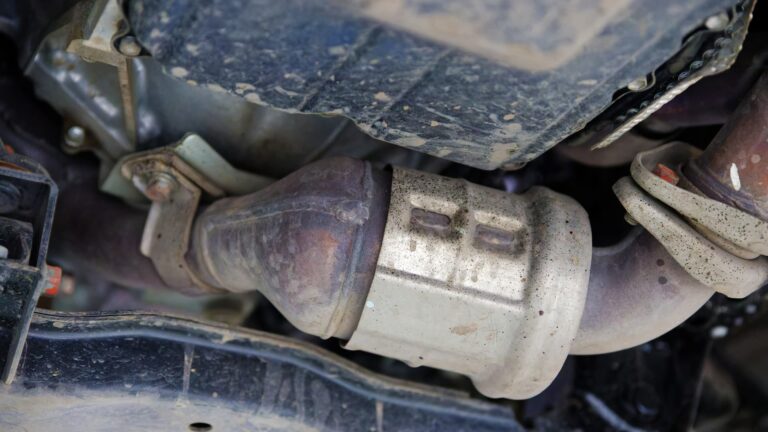Is Replacing a Catalytic Converter Hard? Unveiling the Effortless Solution!
Replacing a catalytic converter is a complex task, requiring specialized knowledge and tools, so it can be challenging for the average person. However, with the right expertise and equipment, it is possible to replace a catalytic converter relatively easily.
A catalytic converter is a crucial component of a vehicle’s exhaust system, designed to reduce harmful emissions. Over time, it may become clogged or damaged, necessitating replacement. We will explore the process of replacing a catalytic converter, providing insights and tips to help you understand the difficulty involved in this task.
We will cover the necessary steps, potential complications, and factors to consider before attempting a catalytic converter replacement. By the end, you will have a clearer understanding of whether this is a job you can tackle yourself or if it’s best left to a professional.
The Role Of A Catalytic Converter In Vehicle Emissions Control
The catalytic converter plays a crucial role in controlling vehicle emissions, specifically in reducing harmful exhaust emissions. With the increasing concern for environmental protection and stricter regulations in place, maintaining the efficiency of the catalytic converter is essential. The converter works by converting harmful gases, such as carbon monoxide, nitrogen oxides, and hydrocarbons, into less harmful substances, like carbon dioxide, nitrogen, and water vapor. This process is facilitated by the use of precious metals, such as platinum, palladium, and rhodium, which act as catalysts.
Over time, the catalytic converter can become clogged or damaged, impacting its performance. When this happens, it needs to be replaced. Replacing a catalytic converter requires specific knowledge and skill, and it’s not a simple task. It usually involves removing and replacing the old converter with a new one, ensuring proper installation and connection. It’s important to consult a professional mechanic or automotive technician for this process to ensure it is done correctly.
Maintaining the functionality of the catalytic converter is crucial for the vehicle’s compliance with emissions regulations and reducing its environmental impact. Regular maintenance and inspection are advised to detect any issues early on and prevent further damage. By taking proper care of your catalytic converter, you can contribute to a cleaner and greener environment.
Signs That Your Catalytic Converter Needs Replacement
If you notice a decrease in engine performance, an illuminated check engine light, or a strange odor coming from your exhaust, these could be signs that your catalytic converter needs replacement. A failing catalytic converter can cause your engine to run less efficiently, leading to a decrease in power and acceleration. It can also trigger the check engine light on your dashboard, indicating a problem with your emission control system. Additionally, a damaged catalytic converter may emit a strong smell of sulfur or rotten eggs from your exhaust. If you experience any of these symptoms, it is important to have your catalytic converter checked by a professional mechanic. Replacing a catalytic converter can be a complex and labor-intensive task that requires specialized tools and expertise. Therefore, it is generally recommended to leave this job to a qualified technician.
Factors That Make Catalytic Converter Replacement Challenging
Factors that Make Catalytic Converter Replacement Challenging
Replacing a catalytic converter can be a complex task due to several factors:
| Location and accessibility | The location of the converter in the exhaust system can vary depending on the make and model of the vehicle. Some may be easily accessible, while others may be located in hard-to-reach areas, requiring the removal of other components for replacement. |
| Heat and corrosion | The catalytic converter operates at high temperatures, causing it to become extremely hot during normal use. Over time, this heat can lead to corrosion and damage, making the removal and installation process more challenging. |
| Integration with exhaust system | The catalytic converter is an integral part of the vehicle’s exhaust system. It is designed to work in conjunction with other components, such as the oxygen sensors and muffler. As a result, replacing the catalytic converter requires careful consideration and proper alignment with the rest of the exhaust system. |
Considering these factors, it is important to seek professional assistance or have a good understanding of automotive repair before attempting catalytic converter replacement.
Assessing The Difficulty Level Of Catalytic Converter Replacement
Replacing a catalytic converter can be challenging, especially if you have limited knowledge and experience with car repairs. Whether you decide to tackle the job yourself or hire a professional mechanic, there are a few important factors to consider.
| DIY vs. professional mechanic | When deciding whether to replace the catalytic converter yourself or hire a professional mechanic, you should assess your own skills and expertise. DIY enthusiasts with experience in car repairs may feel confident enough to perform the replacement. However, it is important to note that improper installation can lead to further damage and emission problems. On the other hand, a professional mechanic has the necessary knowledge and tools to ensure a proper replacement. |
| Tools and equipment required | If you choose to replace the catalytic converter yourself, you will need a variety of tools and equipment. These may include jack stands, a wrench, a socket set, a jack, and safety goggles. Having the correct tools is essential for a smooth and safe replacement process. |
| Time and effort involved | Replacing a catalytic converter can be time-consuming and requires a significant amount of effort. The process involves lifting the vehicle, removing the old catalytic converter, and installing the new one. Depending on your experience and the condition of your vehicle, it may take several hours or even a full day to complete the replacement. |
Before attempting a catalytic converter replacement, carefully evaluate your skills, the availability of tools, and the time and effort required. If you are unsure or not confident in your abilities, it is highly recommended to seek assistance from a professional mechanic to ensure a successful and safe replacement.
Step-by-step Guide For An Easier Replacement Process
Replacing a Catalytic Converter:
Need to replace your catalytic converter? Here is a step-by-step guide to help you through the process.
| Gathering the necessary materials and tools: |
| – Protective gloves and safety goggles |
| – New catalytic converter |
| – Wrenches and sockets |
| – Jack and jack stands |
Jacking up the vehicle and ensuring safety:
To begin, park your vehicle on a level surface and engage the emergency brake. Place the jack securely under the vehicle and lift it until the wheels are off the ground. Support the vehicle using jack stands for added stability. Ensure proper safety precautions are followed throughout the process.
Disconnecting and removing the old catalytic converter:
Locate the catalytic converter, typically underneath the vehicle. Use wrenches and sockets to detach any connection points and carefully remove the old catalytic converter. Be cautious as the converter may still be hot.
Installing the new catalytic converter:
Position the new catalytic converter in place and reattach all connection points. Ensure each connection is secured tightly. Follow the manufacturer’s instructions for specific installation requirements.
Testing and inspecting the newly replaced catalytic converter:
Start the vehicle and listen for any unusual noises or vibrations. Check for any exhaust leaks or emissions issues. Take your vehicle for a test drive to ensure everything is functioning correctly. If any problems persist, consult a professional mechanic.
Benefits Of Opting For Professional Help
Benefits of Opting for Professional Help
One of the main advantages of choosing professional assistance for replacing a catalytic converter is the experience and expertise that professionals bring to the table. They have the necessary knowledge and skills to handle the process efficiently and ensure that the job is done correctly.
Another benefit of going with professionals is that they have access to the proper equipment and facilities required for the task. Catalytic converter replacement involves working with specialized tools and machinery, which may not be readily available to individuals attempting the job themselves.
Additionally, professional service providers often offer warranty and guarantee coverage for their work. This means that if any issues arise after the replacement, the professionals will take responsibility and rectify them without any extra cost to the customer. This provides peace of mind and ensures that the job is done to a high standard.
Making An Informed Decision For Catalytic Converter Replacement
Replacing a catalytic converter can be a challenging task depending on your level of expertise and experience. For those who are well-versed in automotive repairs and have access to the necessary tools, tackling this job as a DIY project can save money. However, there are important factors to consider before making a decision.
It is crucial to weigh the pros and cons of DIY vs. professional catalytic converter replacement. While DIY might seem attractive due to cost savings, it is essential to evaluate the ease of the replacement process. Some vehicles have catalytic converters that are easily accessible and can be replaced with minimal effort. On the other hand, certain models have more complex configurations, making DIY replacement challenging for even experienced DIY enthusiasts.
Another critical consideration is ensuring compliance with environmental regulations. Catalytic converters play a vital role in reducing harmful emissions. If not replaced correctly, it can lead to issues such as increased pollution or even failing emission tests. Professionals are knowledgeable about the specific requirements and can ensure compliance, giving you peace of mind.

Credit: www.way.com
Frequently Asked Questions On Is Replacing A Catalytic Converter Hard
Is It Hard To Change Your Catalytic Converter?
Changing your catalytic converter can be challenging, but with the right tools and knowledge, it can be done. Ensure you follow safety precautions and consult a professional if needed.
Can I Change A Catalytic Converter Myself?
Yes, you can change a catalytic converter yourself. Make sure to follow proper safety precautions and use the right tools. Additionally, consult your vehicle’s manual or online resources for step-by-step instructions. Regularly check local regulations regarding emissions standards to ensure compliance.
How Long Does It Take To Replace A Catalytic Converter?
The time to replace a catalytic converter depends on the make and model of the vehicle. Generally, it can take around 1-2 hours to replace a catalytic converter. However, additional time may be needed for diagnosing the issue, sourcing the replacement part, and fixing any other related problems.
Is It Worth It To Replace A Catalytic Converter?
Yes, it is worth replacing a catalytic converter. A new one helps reduce emissions and improves vehicle performance.
Conclusion
Replacing a catalytic converter may not be a task for beginners, but it is an essential repair to ensure your vehicle’s emissions system is functioning properly. Hiring a professional mechanic is often the best course of action due to the complexity involved.
With the right expertise and tools, the process can be completed efficiently and effectively, ensuring your vehicle meets environmental standards and continues to perform optimally.






